The Metaverse: When virtuality becomes reality
The metaverse is a 3-D immersive environment that seamlessly combines the real and the virtual worlds to provide a space within which users may live out their lives. This may be to work, relax, consume entertainment, play games, socialize, or to engage in activities with others as you do in offline spaces. In all these cases, entry to the metaverse is dependent on internet access and having the right kind of headgear. At present, the most notable and impressive metaverse platforms are The Sandbox and Decentraland. Despite having attracted a significant userbase, they have yet to fully realize the complete vision of the metaverse.
The metaverse differs from 3-D games in that the metaverse: (i) is ongoing and operates ceaselessly; (ii) contains many different activities that occur simultaneously; (iii) is open and accessible to all; (iv) encompasses a fully functioning economic system; (v) has broad scope that extends to include both the virtual and the real worlds; (vi) can operate cross-platform; and (vii) includes content and experiences that are produced by the users themselves. In addition, the structure of the metaverse is such that it can be viewed as a seven-stage value chain. Alternatively, it can be thought of in terms of its primary components that fall into the two principal groups of technology and infrastructure. Though most have yet to be fully developed, these can be subdivided into fourteen supporting pillars.
Despite its infancy, companies in a broad swath of industries, including those in retail, beauty and fashion, restaurants, entertainment, banking and finance, education, and even the public sector, are now investigating how they might transition their activities to the metaverse. Meanwhile, Thai developers have also announced that they are developing their own domestic metaverse platforms.
Nevertheless, considered through the PESTEL framework, while the metaverse benefits from the help provided by many supporting factors, its development faces problems with regard to access to and development of the requisite technology. Given this, it is expected that it will take at least another 5-10 years before the metaverse sees widespread adoption, with players in the gaming, entertainment, and advertising industries most likely to offer metaverse services initially.
Krungsri Research believes that for banks and providers of financial services, the virtual economy will become their playing field. Banks, however, will need to adapt to offer products that are related to digital assets. In addition, it will be possible to use the metaverse to improve both customers’ and employees’ experiences, even if banks will at the same time need to develop new models for assessing risk.
Introduction: When the virtual becomes real
In 1999, the famous science-fiction trilogy The Matrix prompted audiences to ponder the question of what they would do if it turned out that everything that they did—their work, their hobbies, and their travel—was nothing more than an illusion taking place within the virtual world of the Matrix. People asked themselves whether, if the real world was in fact awful, dark and filled with hopelessness while the virtual world was beautiful and brimming with joy, which would they pick? Would they stay in a virtual world where life was perfect, or would they want to face a darker reality as they tried to free themselves and confront the truth?

A decade after this, technological advances allowed humans to travel for the first time to this new world, which was made accessible by putting on a VR (Virtual Reality) headset. Augmented reality (AR), which mixes the real and virtual, also began to become available through mobile and computer applications, most famously in the case of Pokemon Go. This allowed gamers to use an app to collect virtual Pokemons that were hidden around the real world, though at this stage, VR and AR technology had found only limited applications, most of which were connected to gaming, and because of this, uptake rates were low.

Over two decades later, the release of the previously unexpected fourth installment of The Matrix in 2021 coincided with the emergence of the technology needed to allow individuals to live out their life in the VR world of the metaverse, and the full realization of this possibility is coming closer and closer all the time. In October 2021, the announcement by the tech giant Facebook that it would henceforth be called Meta caused much of the world to stop and scratch its collective head, asking “What’s the metaverse?’’ Following this, in January 2022, Microsoft announced the purchase of Activision Blizzard, a major games company, with Microsoft CEO Satya Nadella justifying the acquisition with the observation that games will play a major role in the development of metaverse platforms, indicating that this second tech giant plans to develop a presence in this space.
When tech giants begin to stir and move, people begin to sit up and pay attention, and apart from wondering just what the metaverse is, people are asking what else they know, or do not know, about it? How will life and work be transformed by the metaverse? Do you need to use money in the metaverse? And providers of financial services, such as banks, are also wondering what their role will be in this new virtual world.
What is the metaverse, and where did it come from?
Although at present, there is no formal fully agreed-upon definition of the metaverse, it is a three-dimensional environment to which people connect via the internet and which seamlessly mixes the real and the virtual worlds. This allows metaverse users to exploit the metaverse as a space within which they can work, relax, consume entertainment services, play games, meet, chat, and engage in shared activities with others, just as they would in the real world from a first-person point-of-view that situates them in an environment that is filled with other objects, again just like the real world. This, together with high-speed internet access, is at the heart of the metaverse, but to enter the virtual world and to have this experience, users need to put on a VR headset or VR glasses, and so these are a crucial prerequisite for participating in the metaverse.
The term ‘metaverse’ first appeared in the science fiction novel Snow Crash, published in 1992 and written by the American author Neal Stephenson. The novel is set in the 21st century during a period when society, the economy, and the government have all collapsed, an event to which the population respond by escaping into the metaverse (a compound of ‘meta’, meaning above or beyond, and ‘verse’, from universe). In the novel, the metaverse is a three-dimensional environment within which users are represented by an avatar and which they access through the internet and special glasses, similar to the VR headsets that are now appearing on the market. It is also noteworthy that within Stephenson’s virtual world, cash has been replaced by encrypted electronic payments that are similar to the cryptocurrencies that have come to prominence recently.
A decade or so after the publication of Snow Crash, in 2003, the computer game Second Life brought the world a step closer to realizing the metaverse. This provided users with access to a three-dimensional world, and having created their own avatar, users could then explore this space and meet and socialize with other participants. This was a PC-based experience, and so moving around and engaging in activities within the Second Life world required use of a keyboard and mouse. In this world, participants were able to engage in economic exchanges that were mediated with the ‘Linden Dollar’, a virtual currency for use within Second Life that was also exchangeable in the real world. Unfortunately, technical limitations meant that the experience of using Second Life fell a long way short of being a full simulation of reality.
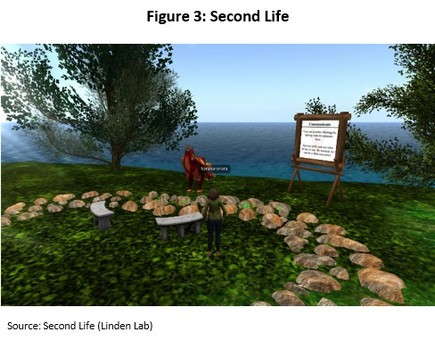
Although Second Life was hampered by the technological limitations that prevailed at the start of the millennium, two decades of progress mean that the current situation has moved on enormously, especially with regard to the internet, the development of which may be split into three phases. Web 1.0 describes the pioneer period from the 1990s through to the start of the 2000s. During this period, users accessed content via personal computers, viewing images or reading text that was delivered from particular servers. As technological change gathered pace, Web 2.0 swiftly emerged to cover more-or-less the whole world. The clearest change that occurred during the transition to Web 2.0 was the prominence of social networks, in which users could connect and communicate. Although at first Web 2.0 was accessed through personal computers, the importance of mobile phones rose rapidly. At the same time, it became easier for users to become content creators, and this allowed Web 2.0 to become the era of the ‘influencer’. The ceaseless advance of technology means that we are already moving out of this period and into that of Web 3.0, which is marked by the use of artificial intelligence (AI) and blockchain technology[1]. In this period of the development of the web, in addition to consuming and creating content, users will be able to build and use their own software and to own and exploit a range of different types of digital assets[2]. Web 3.0 will also support the full emergence of the metaverse (Table 1).
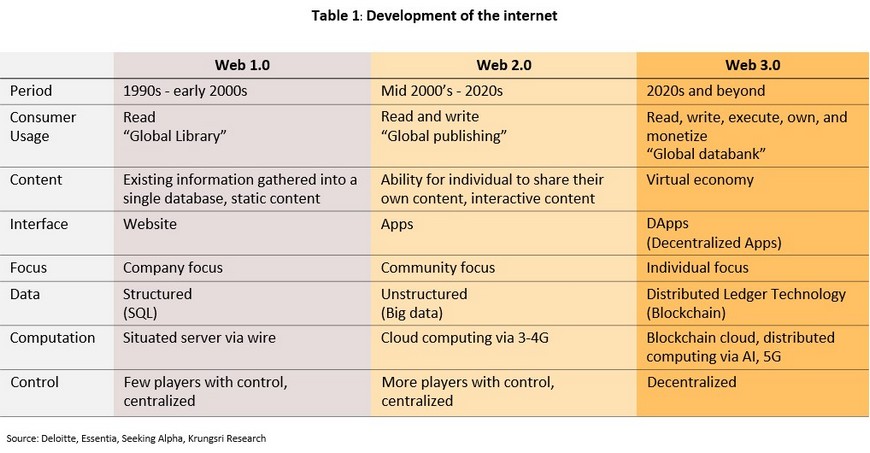
The Decentraland platform, which offers access to a virtual world, is one of the results of the overlap between the Web 2.0 and Web 3.0 eras. Decentraland users can create avatars that they use to move around within the virtual world, play games, and meet and chat with other users, making the experience similar to that offered by Second Life, though with much better and much more modern graphics. Users are also able to purchase land and other assets within the virtual world and to hold ownership of these in the form of NFTs[3], with purchases made using the platform’s own MANA currency. Buying and selling digital assets is made convenient as the platform is built on the Ethereum blockchain. This facilitates the making of transactions with digital assets and allows for the extension of future transaction capabilities. Decisions are enforced and automated through the use of smart contracts and DAOs (Decentralized Autonomous Organization[4].) One of Decentraland’s strengths lies in the ability it provides to users to manage events and to build networks, although users may be distributed through servers and so they may not meet every time they enter the system[5]. Overall, though, Decentraland represents a further step towards achieving the vision of the metaverse.
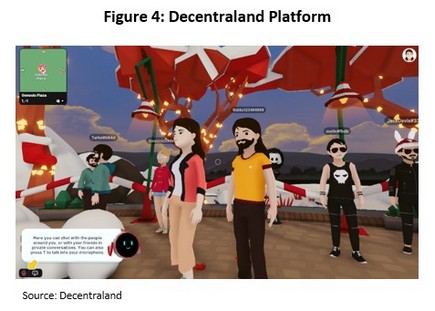
In addition to Decentraland, The Sandbox offers an experience similar to the idea of the metaverse. The platform uses 3-D voxel graphics and is built on a blockchain that allows users to buy and sell land within the virtual world. The Sandbox’s principal attraction, nonetheless, is the large range of games that it offers. Since most users are also gamers, this makes it an attractive proposition. Purchases of assets may be made in The Sandbox using the SAND digital currency, and objects created within the platform are automatically converted into NFTs. At present, The Sandbox has a 62% market share of all land for sale in the metaverse[6] and has partnered with over 50 businesses, making it the market leader among metaverse offerings.
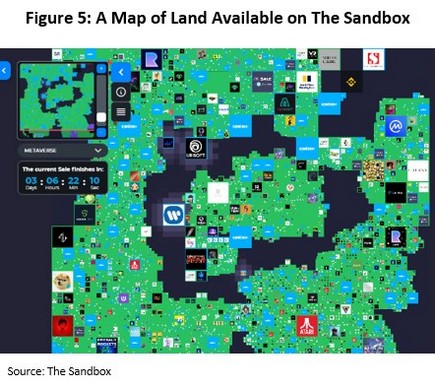
Other metaverse-like platforms that are currently in operation include CryptoVoxels, known for its many digital art galleries, Roblox, which attracts an average of 47 million users a day, and Somnium Space, which offers a very attractive 3-D environment. However, in one way or another, these platforms all fail to qualify as full metaverses since they lack one or more of the metaverse’s defining characteristics. These will be discussed in the following section.
Structure and characteristics of the metaverse
Ball (2020) has summarized the major features of the metaverse that distinguish it from 3-D games, as follows:
- Operations are persistent and so unlike regular games, the metaverse environment operates constantly without any possible completion, restart or ‘game over’.
- Activities carried out on the platform are synchronous and live. Experiences in the metaverse are live and occur in real time and although activities may be set up in advance, actual interactions unfold naturally. This is unlike playing games through a VR headset, when the images and sound that are experienced will have been recorded or designed in advance.
- The platform is open to all, and users may enter the virtual space without limit. Users will also feel that they are physically present in the space, not that they are sitting and watching a TV.
- A metaverse platform should encompass a fully functioning economy. Individual users and organizations operating within the metaverse should be able to create, own, invest in, and buy and sell goods and services within the metaverse. Although these may differ from the kinds of goods and services available in offline environments, all that is required is that value is created, and buyers are ready to exchange digital money for these.
- The metaverse has a broad scope that includes both the digital and the real worlds. Access to both open and closed platforms may be made through public or dedicated networks.
- Metaverse platforms should be interoperable so that it should be possible to buy or sell data, content, virtual objects, and assets across platforms. For example, users should be able to buy a virtual item of clothing on the Decentraland platform, wear it on The Sandbox, and sell it or give it as a present to someone on Facebook. However, interoperability remains a major problem with current 3-D metaverse platforms, and exchanges remain restricted to single platforms only.
- Users should participate in the creation of content and experiences. All users within the metaverse should be able to create content, rather than this being reserved for particular organizations or influencers.
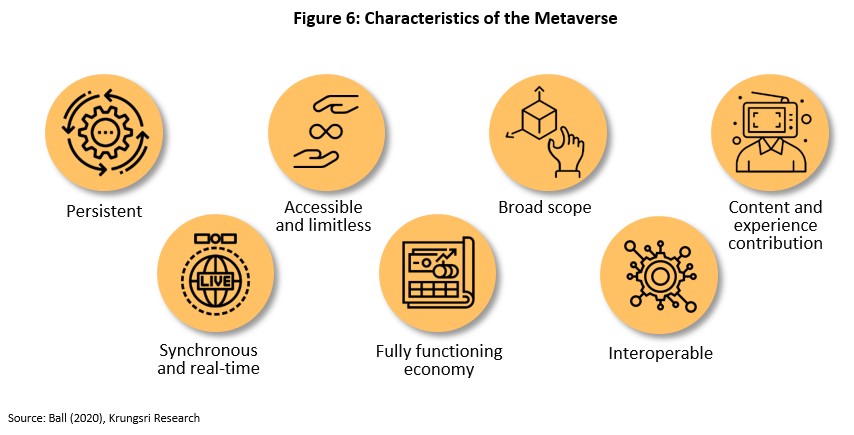
Although the metaverse has its roots in the worlds of gaming and entertainment, in the future, uses for the metaverse will expand to encompass much of daily life, including communication, work, education and training, and even tourism and participating in events with others. Considered as a value chain and analyzed in terms of core activities, as per Radoff (2021), there are seven major levels to the metaverse as described below, arranged from those in the most downstream position, where users will connect with and experience the metaverse, or what might be considered its demand side, through to upstream positions that support the operation of the metaverse, or what might be called its supply side.
Level 1: Experience. This includes gaming, participating in virtual events, and spending money and making purchases in the virtual economy. This is the level at which most users will interact with the metaverse.
Level 2: Discovery. Users will encounter the possibilities offered by the platform through: (i) inbound channels, such as users looking for information relating to experiences themselves as they occur, using search engines, or being spurred to act by social pressures; and (ii) outbound channels, such as advertising and push notifications.
Level 3: The creator economy. This allows users to become creators who can easily produce new content and experiences for use within the metaverse, and then to retain ownership of this without restrictions on their coding ability.
Level 4: Spatial computing. This allows user movements in the real world to be faithfully represented within the virtual world, thus helping to bind the two together more tightly.
Level 5: Decentralization. Unlike the situation imagined in the films The Matrix and Ready Player One, at the heart of the idea of the metaverse is the belief that it should not be under the control and management of any individual or organization. This also implies that metaverse platforms should implement cross-platform interoperability and their internal economies should be robust and competitive.
Level 6: Human interface. This includes hardware to communicate with the user, such as VR glasses or other headwear, mobile phones, smart gloves, and other devices that will no doubt appear in the future.
Level 7: Infrastructure. This extends to encompass 5G networks, cloud computing systems, and the electrical system needed to support the user experience.
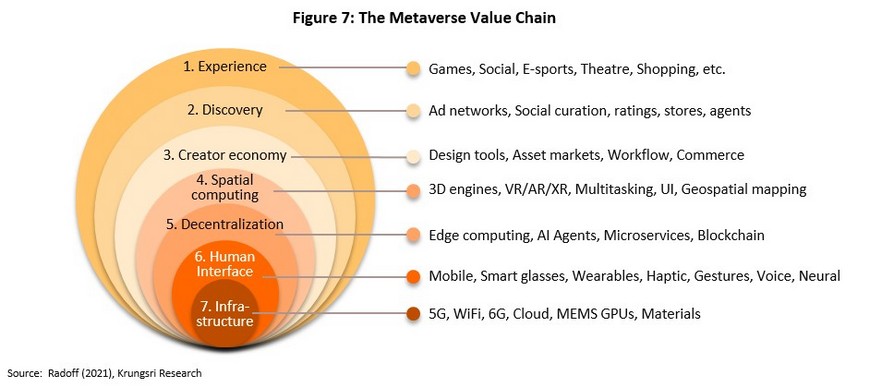
In addition to being viewed through the framework of value chains, research by Lee et al (2021) shows that the metaverse can be considered in terms of the two aspects of technology and ecosystems. This is thus discussed below.
1.Technology: This is composed of eight primary pillars.
- Extended reality (XR): The principal technology underpinning the metaverse will be an improved version of current technology that includes AR, VR and MR (or mixed reality[7]) and that allows for the creation of an extended reality (XR). This will mix AR, VR and MR capabilities together to produce a virtual reality environment that is integrated into the real world and that permits users to interact with one another with the help of the internet and equipment such as VR headsets. However, at present, the technology required to bring XR to market is still under development.
- User interactivity: To allow free-hand interaction between metaverse users as both subject and object of interactions, and to make this as close as possible to the types of interactions that occur in the offline world, the development of user interactivity is crucial for the metaverse. Such interactions should not involve the use of current technologies such as the keyboard and mouse, and this will thus require the development of new technologies to support this role, including computer vision (details are given below) and other mobile-input techniques. Beyond this, the use of mobile headsets will also be an important step on the route to making available metaverse technology that interacts directly with users.
- Blockchain and AI: At present, virtual worlds exist on platforms that are isolated from one another, and so users are not able to transfer virtual goods or currencies between platforms. When they are on one platform and they wish to do something on another, they need to exit the first before they can enter the second. This then makes the experience less that of being in a metaverse and more that of walking in and out of a series of “meta-rooms”. It is however hoped that in the future, metaverse platforms will be built on blockchains that are interoperable or that use cross-chain routers, which would then help to enable users to interact on multiple platforms seamlessly and to experience this as if it were all taking place within a single unitary virtual world, much as life takes place in the real world. When virtual worlds are connected in this way and platforms become interoperable, the resulting flow of information will be enormous, and collecting and processing this will require the use of AI technology. In the future, this will then allow for the creation of automatic digital twins[8], computer agents[9], and autonomy of avatars.
- Computer vision: This uses AI to train computer systems to understand and respond to visual information. Using this, computer programs are able to analyze still and moving images, distinguish different objects within these, and then gather data from these inputs. Computer vision thus plays an important role in building three-dimensional virtual worlds within the context of XR. Computer vision is also used for human pose tracking[10], which can then be used to control avatars.
- Robotics and the internet of things (IoT): Robotics and the IoT will help metaverse users to more fully integrate their offline and online experiences, especially with regard to metaverse-based interactions. These two factors will act as tools that will make life more convenient for users (e.g., with home assistant robots, service drones, and public security robots), help to manage information flows shifting between real and digital environments, and assist with movement and transport in physical spaces using autonomous vehicles, by which they will also help to add to the metaverse experience.
- Edge computing and cloud data storage: Because linking real and virtual worlds within the metaverse will require the ability to gather and analyze a tremendous quantity of data, it will be necessary to reduce the load placed on portable devices such as mobile phones and instead use cloud-based data storage technologies. Edge computing11/ will also find a role in allocating cloud-based processing power in the most efficient way, for example by using resources located closest to data sources to speed up data access. Exploiting these services will also help to ensure that the privacy and safety of metaverse users is maximized.
- Internet networks: This will have an extremely important role to play in the development of the metaverse, from big data collection and analysis, to accessing databases and facilitating communications between automatic systems embedded in mobile devices and cars. These demands are then amplifying the importance of the new networks that will supplant current 5G technology.
- Hardware and infrastructure: This provides the basis on which the entire metaverse is constructed and covers both the devices that must be worn to access the metaverse, such as VR headsets (now being sold by Oculus Quest, which is owned by Meta), and other equipment such as robots and vehicles, as well as the network infrastructure and power systems that sustain the whole operation.
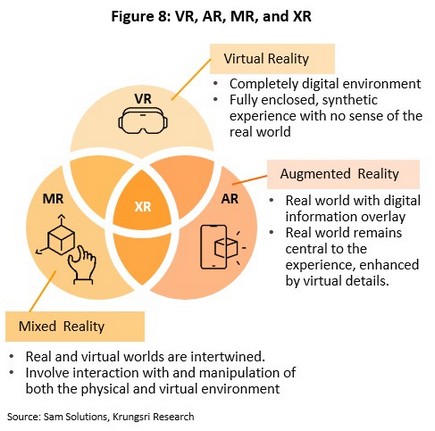
2. The metaverse ecosystem is built from six pillars.
- Avatars: These provide the means by which users can communicate and interact with one another and with objects within the virtual world. In the Web 1.0 and Web 2.0 eras, avatars were limited to being simply profile pictures that were displayed in chat rooms, blogs and on social media. In the metaverse, however, avatars will play a much more important role, and as a digital manifestation of the user, they will allow that user to experience the virtual body as real and to increase the believability of virtual activities from the standpoint of other users. Successfully creating avatars relies on the technologies described above, especially computer vision since this will allow the capture of users’ expressions and emotions and then to display these on the avatar in as life-like a way as possible.
- Content creation and management
- Content creation – All metaverse users, both professionals and amateurs, will be able to create content to be consumed within the metaverse, whether that is artistic creations (e.g., illustrations or music), materials for use in day-to-day life (e.g., in meetings or training sessions held in the metaverse), or livestreamed sales channels. When creating content for the metaverse, users will not only turn to AI applications to help them more easily construct digital objects that are transferred in from the real world, but will in fact make use of all eight technological pillars described above, as well as possibly relying on additional tools such as smart gloves to speed up the creation of digital objects. In return for creating content, users will be rewarded with digital tokens, e.g., NFTs that can then be exchanged for money offline.
- Content management – Given the potentially unlimited number of creators, it is likely that the metaverse will have to house a huge quantity of data. To manage this, edge and cloud computing technologies will need to be employed. In addition, it may be necessary to censor content that is risky or illegal, and careful thought needs to be given to questions such as who will be responsible for censorship, what will be censored, whether censored content will be stored, and if so, who will have the right to see this. In addition, questions remain over what the process will be for managing content as it ages and loses its interest. Will this be preserved in a virtual museum or in a digital warehouse so that it can be retrieved in the future?
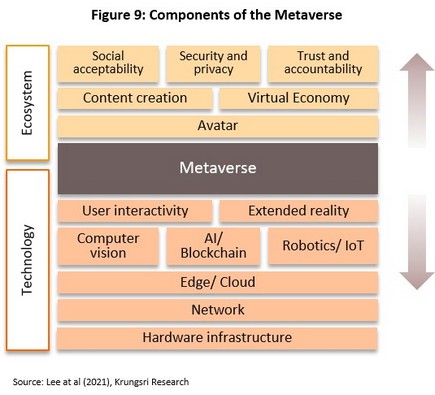
- The virtual economy, or Metanomics: Because it is possible to buy and sell virtual goods and digital assets in the metaverse, there are many interesting questions surrounding the economy that it contains, and to forestall problems, thought needs to be given to these in advance.
- Metaverse money: Digital assets, in particular cryptocurrencies, will be the central medium of exchange within the metaverse, though problems that may affect this will include the following.1) The value of cryptocurrencies tends to fluctuate wildly, making it difficult to use this as a stable payment mechanism within the metaverse.2) The supply of cryptocurrencies is limited by design, and money creation through mining is a slow process. As such, using cryptocurrencies within the metaverse economy would tend to be deflationary[12].3) To address the second problem, some might be tempted to establish a new cryptocurrency with a fixed exchange rate relative to an existing currency, though this might generate problems similar to Gresham’s law, as was seen in Europe and the US in past centuries[13]. Rather, it might be necessary to use a mechanism that govern a cryptocurrency similar to the money in the offline economy, for example by using a legal reserve requirement for cryptocurrency. This, however, would then run counter to the crypto ethos and the desire to be decentralized and free from government interference.Another alternative might then be to use stablecoins[14] and/or CBDCs[15] since these have a more stable value, though at present, there is little sign of either of these gaining acceptance on metaverse platforms.
- Trading of virtual goods: Users will be able to buy and sell digital assets and virtual goods in the metaverse in the form of NFTs that encode unambiguous ownership information. This might include everything from clothes and accessories for avatars through virtual pets, songs, and artworks, to land and property. However, the price of these goods will not reflect their utility value so much as their novelty, branding, identity, and scarcity. This would then make pricing virtual goods similar to that of luxury or Veblen goods. Analyzing and predicting demand for goods in the metaverse would thus require something beyond what is taught in general microeconomics textbooks. In addition, problems with imitations and infringements of intellectual property rights are likely to pose a significant challenge. Operators of metaverse platforms will need to devote resources and attention to vetting goods before allowing these to be distributed as NFTs.
- Commercial platforms within the metaverse: Commerce will take place within the metaverse as an extension of current B2C (business to consumer) and C2C (consumer to consumer) e-commerce. This will however differ importantly from the latter with regard to the types of goods sold, which in the case of the metaverse will likely be virtual goods for use only in the metaverse, and the type of purchases, which in the metaverse will be for interoperable goods that a consumer will be able to buy on one platform but use within the environment of another. Metaverse commercial platforms might therefore have a dedicated trading space.
- Competition between metaverse operators: Because developing metaverse platforms is difficult and costly, the supply of these is likely to be severely constrained. The market is thus expected to be oligopolistic in nature. This then means that whether services differ significantly from one another or not, providers are very likely to make stronger profits than they would do in a more competitive market, and they may even be able to engage in price collusion. It is therefore important that competition between service providers is fair, though it is not clear which organization or mechanism should be entrusted with ensuring that this outcome is reached. If a public sector organization is tasked with this, this may conflict with the decentralized principles of the metaverse. Nevertheless, if metaverse operators can provide a good service and so generate substantial profits, there is a strong possibility that major players in other industries will look to enter this market to compete with current providers by forming new business partnerships or by engaging in joint ventures. The outcome would likely be to increase competition on the supply side of the market.
- Economic governance: Setting out the boundaries within which public sector agencies might operate to manage the economic life of the metaverse is a difficult matter. Questions that might come under the purview of the regulatory authorities include the legality of using cryptocurrencies and other digital assets as a means of payment, how best to help consumers by promoting competition between metaverse service providers, and how to control illegal activities and the use of cryptocurrencies for money laundering. Beyond this, a major problem facing the authorities when dealing with a decentralized system like the metaverse is what to do if or when it is hit by an economic crisis, since within the metaverse and unlike in the real-world economy, state agencies may lack the tools required to provide assistance or to stabilize its financial system.
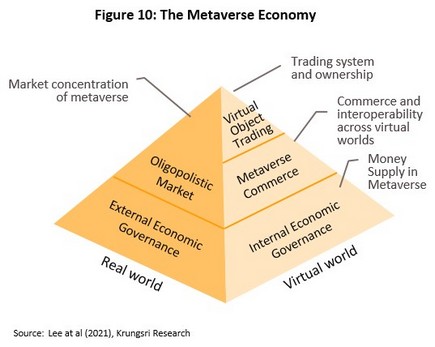
- Social acceptability: Several social issues arise as a result of transferring normal human relationships from the real world to the environment of the metaverse. These are described below.
- Diversity of the userbase: The metaverse should appeal to a diverse range of users with regard to their gender, nationality, ethnicity, religious background, and age. One way for this to be manifested is in users’ avatars. In addition, content creators also need to be alert to this diversity and to be careful that their material is appropriate for all users.
- Maintaining rules and enforcing fairness: Because there is likely to be many meta-rooms within the metaverse, each of which will have its own rules and regulations. Operators will then likely rely on AI and machine learning to enforce the rules fairly in a mathematical and logical way. Unfortunately, with machine-enforced rules, human users are likely to feel aggrieved and alienated, and so channels should be set up that will allow users to recommend better outcomes to the system, which could then use these as a learning input and so improve its overall efficiency.
- Addiction to the metaverse: It is possible that the obsession with using mobile phones and being online that currently troubles some people may worsen significantly when the full metaverse experience becomes available, as some users may flee reality and instead spend extended periods of time immersed in the metaverse. This possibility also raises fears about the impacts on the physical and mental health of users, as well as raising the specter of behaviors being shaped by the experience of being in the metaverse.
- Cyber bullying: This term covers a wide range of activities, from expressing negative opinions towards others and sending them insulting messages, through social exclusion and slander, to identity theft and impersonation. This has been a feature of life online since the earliest days of Web 1.0, and these behaviors are likely to be just as pervasive in the metaverse. Such activity may lead to the closure of meta-rooms where this is common, but identifying cyber bullying is no easy matter. For AI moderators, cases may appear ambiguous or obscure and they may thus slip through. Nevertheless, it will be important for metaverse operators to set up systems to assist victims.
- Other social issues: It remains to be seen how intergenerational use of the metaverse will evolve and how different generations will get along within the virtual world since at present, online platforms clearly appeal to different generational userbases. In addition, it is not clear what will happen when users die and how the user’s family or the system will manage the deceased user’s avatar and personal data. Should extended families be able to interact with the 3-D representation of the deceased user’s data, or should this be restricted to close family members only? Platform operators will need to consider these and other related problems.
- Security and privacy: Much of the Web 2.0 experience involves gathering personal data to produce targeted advertising, but the transition to the full metaverse experience will enormously expand the potential of these mechanisms. As such, much attention will need to be given to how to set boundaries to the harvesting of personal information, and laws will then need to be drafted to enforce this. It may be possible to develop mechanisms that permit individuals to make informed decisions to sell their own data. The metaverse will also generate an enormous quantity of data from a range of sources including VR headsets and home-based smart devices, which will collect many different types of information, from simple personal facts through behavioral data to information on communications with others. Although revealing this data to metaverse operators may improve the experience, this will also raise fears regarding privacy and safety. Research by Leenes (2007) shows that in Second Life, users’ in-game activity closely matched their real-world behavior, and so it is entirely possible that metaverse users will inadvertently disclose their behavioral data. Other safety issues relate to the possibility of creating deepfakes, which use AI to create fake audio and video recording of individuals that are almost indistinguishable from the real version, managing and controlling the creation of digital twins, and safeguarding biometrics.
- Trust and accountability: Another significant social issue concerns the need to establish a mechanism for building trust in the metaverse. If users treat the metaverse as being radically distinct from the real world, interactions within it will likely differ significantly from in-person interactions, much as disguising identities in chatrooms in the Web 1.0 era damaged and restricted online life. Thus, if a large number of metaverse users are not committed to these interactions, there is a risk that the experience will reduce to being just another game played out in a three-dimensional immersive environment. On the other hand, if users, and especially the elderly, are too trusting in their metaverse interactions, they may fall victim to identity theft or other types of fraud. Maintaining a balance between these two extremes will therefore be another area that both operators and users will need to negotiate.
Given the above, it is clear that whether one views the metaverse through the framework of value chains or through Lee et al’s (2021) dissection of the metaverse’s component parts, the resulting analyses share overlapping and connected structures, as shown in Figure 11.
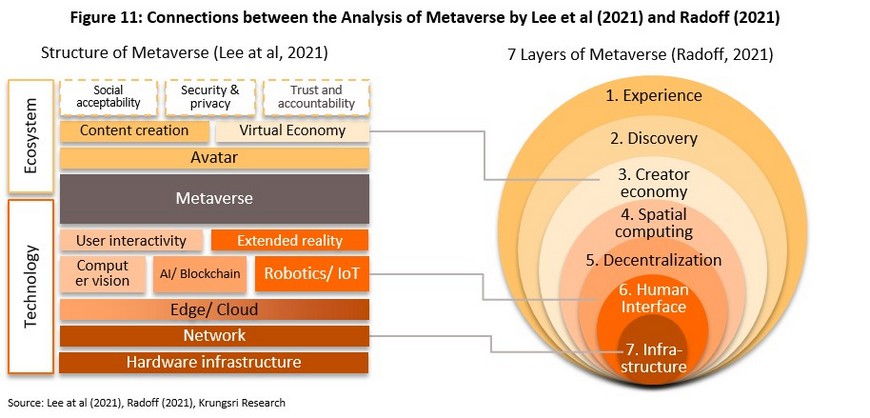
Regardless of whether one views the metaverse through the lens of value chains or of its component parts, the present level of technological development is not sufficient to support a fully life-like metaverse experience. With regard to both users and the metaverse ecosystem, questions remain unanswered with regard to management and oversight, and even with the exponential pace of technological development, it will take at least 3-5 years for the separate parts of the jigsaw to fall into place, and only subsequent to this will it be possible for the metaverse to gain wider acceptance and use.
Although the prospect of the metaverse’s full realization remains somewhat distant, we can begin to see component parts taking shape, and these will ultimately coalesce into a virtual space that seamlessly connects to the real world. This may be what Mark Zuckerberg sees, and his vision is sufficiently clear that he feels confident to tie the future of his one-trillion-dollar company (THB 34 billion, or roughly twice the size of the entire Thai economy) to an idea that at present remains distant and which many dismiss as little more than an online game.
Who is preparing to step into the metaverse?
In February 2022, Gartner forecast that by 2026, a quarter of the world population would be spending at least an hour a day in the metaverse to work, spend, study, communicate, or consume media and entertainment[16], meaning that within just 4 years, there would be at least 1.5 trillion metaverse users globally[17]. This surprising outlook is, however, in accord with research by Emergen Research, which indicates that by 2028, the global metaverse market will be worth USD 829 billion (around THB 27 trillion). The most valuable segment will be hardware (including headsets), and around half of the market will be located in North America[18].
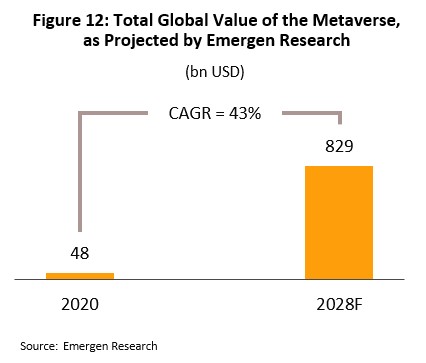
In addition to Facebook and Microsoft, which have already been clear that they see both their company’s and the world’s future tied up with the metaverse, major corporations worldwide that are active in industries outside the gaming and tech worlds are also steadily revealing plans to enter this market and to try to secure for themselves as large a slice of the cake as possible. Examples of these are given below.Retail, beauty and fashion
The retail sector appears to be responding rapidly to the emergence of the metaverse, with the American retail giant Walmart announcing plans to sell all manner of virtual items, including electrical goods, toys, home appliances, sports equipment, clothes, home decorations, and many other product categories. Indeed, it could be said that Walmart is simply cloning its offline shops into the metaverse. The company has also released a video demonstrating how to make purchases in the metaverse, and although responses to this have been somewhat muted by the fact that the current user experience fails to live up to expectations, in the future, Walmart plans to expand its activities to include issuing a digital currency (the details of this are not yet clear) and to trade in NFTs[19].
In addition to opening shops within the metaverse, some brands are currently moving into the sale of virtual fashion goods. For example, RTFKT, which has been bought by Nike, sells virtual shoes as NFTs, while Gap, Under Armour, Skechers, Balenciaga and Adidas have all announced that they too will begin selling NFT virtual clothes, and extending these sales into the metaverse should be relatively straightforward. Beyond this, L’Oréal has also registered trademarks for 17 types of virtual goods that it will sell through cosmetics brands that are part of the L’Oréal group. These include perfume, hair-care products, and cosmetics, all for use in virtual environments including the metaverse[20].Restaurants
At the start of February 2022, the fast-food giant McDonald’s applied to register trademarks for the retail of virtual and physical goods. The company has also set up a virtual restaurant that also offers home delivery services, and has filed for trademarks covering the organization of on- and offline concerts. In a similar manner, Panera Bread, an American bakery, has filed applications for comparable trademarks, though it takes the US Patent and Trademark Office around 8-9 months to consider these, and so it waits to be seen what the outcome of this will be[21].The entertainment industry
A large number of artists and performers have seen the potential of the metaverse as a way of organizing concerts and other events. Warner Music has therefore constructed an online music world within The Sandbox, where it can host virtual concerts[22]. This platform has been used to host virtual concerts by other performers, including Snoop Dogg[23], who has said that he will establish a record label for the distribution of music NFTs[24]. Likewise, the South Korean music giants YG Entertainment and SM Town have announced that they are forming a strategic partnership with Binance, a major global cryptocurrency exchange and provider of multichain linking services, to set up a metaverse platform and to develop NFTs for fans of musicians on these labels[25] [26], while SM Town is also building SM Town Land on The Sandbox[27]. At the same time, executives from the family entertainment industry giant Disney have shown that they have a clear vision of how the metaverse will open future opportunities for their company[28].Finance and Banking
JP Morgan, America’s largest bank, has opened a ‘lounge’ on Decentraland to respond to strong interest in the metaverse among its clients. This points to the business potential of the virtual world, especially with regard to sales of virtual property, for which prices doubled in just six months in the second half of 2021[29]. This coincided with the start of interest in Thailand in buying and selling land in the metaverse, which followed on from the announcement by SCB10X (part of the SCB group) that it had bought virtual land in The Sandbox and that it intended to establish a head office there during 2022. This will then be used for activities including hosting talks, seminars, and exhibitions of NFT arts created by Thai artists, meeting with executives virtually, and providing banking services through a virtual branch office[30]. Data from MetaMetric Solutions shows that sales of land in the metaverse in the form of NFTs on the four main platforms (The Sandbox, Decentraland, CryptoVoxels, and Somnium) had a value of USD 501 million in 2021 and this is expected to double this year[31].
In addition to benefiting from sales of virtual land, overseas commercial banks plan to use the metaverse as a means of reaching other goals. For example, Bank of America (BoA) has announced that it will arrange training sessions for staff to help them service clients in the virtual world. Staff will thus be trained in how to build customer relationships, how best to navigate difficult conversation, and how to listen and respond with empathy, all while using VR headwear. This will be an important step to being able to offer full banking services in the metaverse, which a corporate strategist from BoA has described a “…a massive opportunity for blockchain technology that will help to get cryptocurrencies widely adopted…” [32]The Public sector
In South Korea, government agencies are active in the development of the metaverse since for many decades now, the economy has been driven by the systematic extension and promotion of the country’s soft power. The public sector’s involvement in the development of the metaverse is thus uncontentious, and the Ministry of Science and IT has set 4 goals to help it achieve this end, these being: (i) to build a metaverse ecosystem; (ii) to nurture 40,000 metaverse professionals; (iii) to support the development of 220 metaverse companies; and (iv) to ensure that the environment within the metaverse is safe for all users and that it can be used to promote the arts and culture, education services, K-pop, and tourism. In addition, there are plans to establish an institute for the teaching of Korean language in the metaverse. These 4 goals are to be realized by 2026, which would help to improve the country’s ranking of metaverse industries from their current position of 12th in the world to 5th [33]
Education
Over the past two years, the Covid-19 pandemic has forced schools and universities to dramatically extend their online activities, and so educational organizations are now able to benefit from moving into the metaverse. Indeed, some overseas universities have begun to offer courses with virtual reality elements. By using VR headwear, students are able to experience a virtual immersion in the environment being studied. Examples of this includes the University of Miami’s course ‘Religion and Sacred Space in the Era of Artificial Intelligence and Virtual Reality[34], and Stanford’s ‘Virtual People’ course, for which over half the lecture time is delivered using VR equipment[35]. In Thailand, Assumption College opened the ‘AC Metaverse’ on February 16, 2022, with this project created and developed by students using the Minecraft platform. In addition to helping students develop their skills in a range of subjects through self-study and by engaging in learning activities within the game platform, the AC Metaverse allows visitors to view NFT artworks created by students and then to bid on these through the OpenSea platform, as well as providing a virtual space hosting metaverse shops and other activities[36]. Two weeks after the opening of the AC Metaverse, Thammasat University announced the opening of the T-verse, a virtual university that is focused on the provision of education services to the Thai and non-Thai general public, allowing those interested to access research carried out at Thammasat and to see innovations produced there[37].
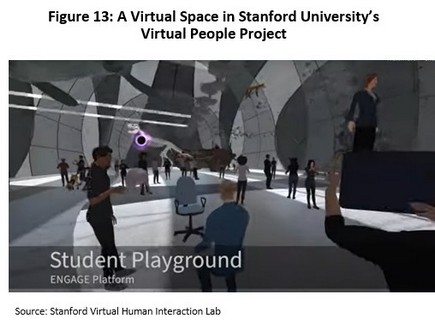
The Thai metaverse
Many Thai software developers and other businesses are in the process of building out their own metaverse platforms. Examples of these include Translucia, which has partnered with the real estate company MQDC to produce a metaverse platform that opened to the public during 3Q21, and MQDC is now helping to develop urban environments and real estate ventures within the Translucia world[38]. Jakaverse is another Thai metaverse platform, and this opened on February 20, 2022. The platform is built on the Binance blockchain and is focused on providing gaming, shopping, tourism, educational, and even health experiences to its users. Jakaverse uses JK as their native currency to facilitate trades on the platform and will soon begin selling virtual land[39]. Brands within the Singha group are also investing in the platform and will begin to offer food-related services[40].
The examples given above show that players from a broad range of industries supplying both physical goods and services are now rushing to stake out space within the metaverse. JP Morgan (2022) has identified the stages that companies will typically need to move through if they are interested in participating in the dash to claim territory in the metaverse.
- Learning: Developing an understanding of the different views about what the metaverse is.
- Assessing: Identifying business opportunities.
- Creating: Seeking new ways to meet customer needs within the metaverse with regard to goods and services, distribution channels, experiences, and related virtual or digital assets.
- Connecting: Joining players within the ecosystem or partnering with other businesses, and identifying and attracting talent.
- Establishing: Building an identifiable presence within the metaverse that is based on a unique selling proposition, possibly by first exploiting the market among technophiles.
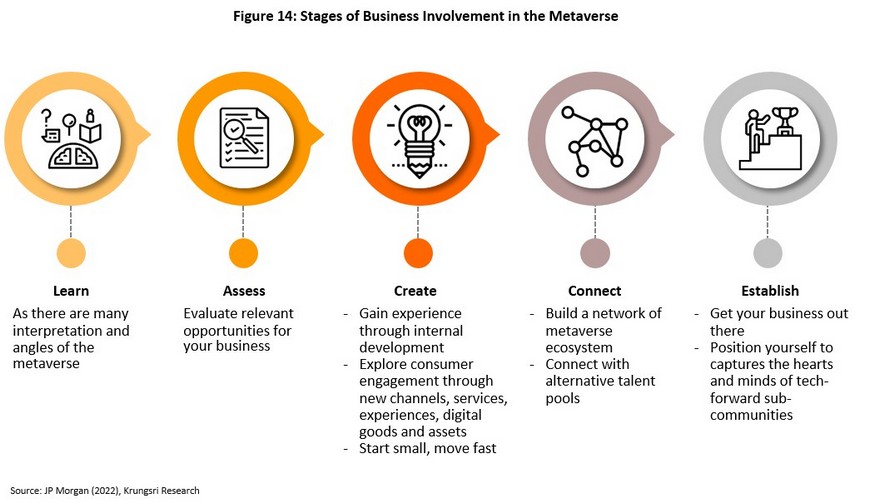
The future of the metaverse: Is that hype or awareness that we feel?
The stampede into the metaverse by businesses worldwide has prompted analysts to call on organizations to step on the brakes. These analysts note that since nobody knows what form the metaverse will take or which platform will achieve dominance, companies may simply be responding unthinkingly to trends that might be only temporary.
To better understand the development of the metaverse in the Thai context, an analysis of the latter using the PESTEL framework is given in Table 2 below. PESTEL is an acronym that identifies the various lenses through which the analysis is carried out, these being the political, economic, social, technological, environmental, and legal. These show that while there is a significant number of factors supporting the development of the metaverse, important challenges remain. Chief among these are the state of technological development and inequality of access to this, and at present some components of the metaverse are still at the stage of being ‘incubated’. In light of these limitations, it is likely to take another 5-10 years before the metaverse begins to play a significant role in the day-to-day lives of the general public, though among early adopters, especially for applications related to gaming, entertainment and advertising, the metaverse will arrive earlier.
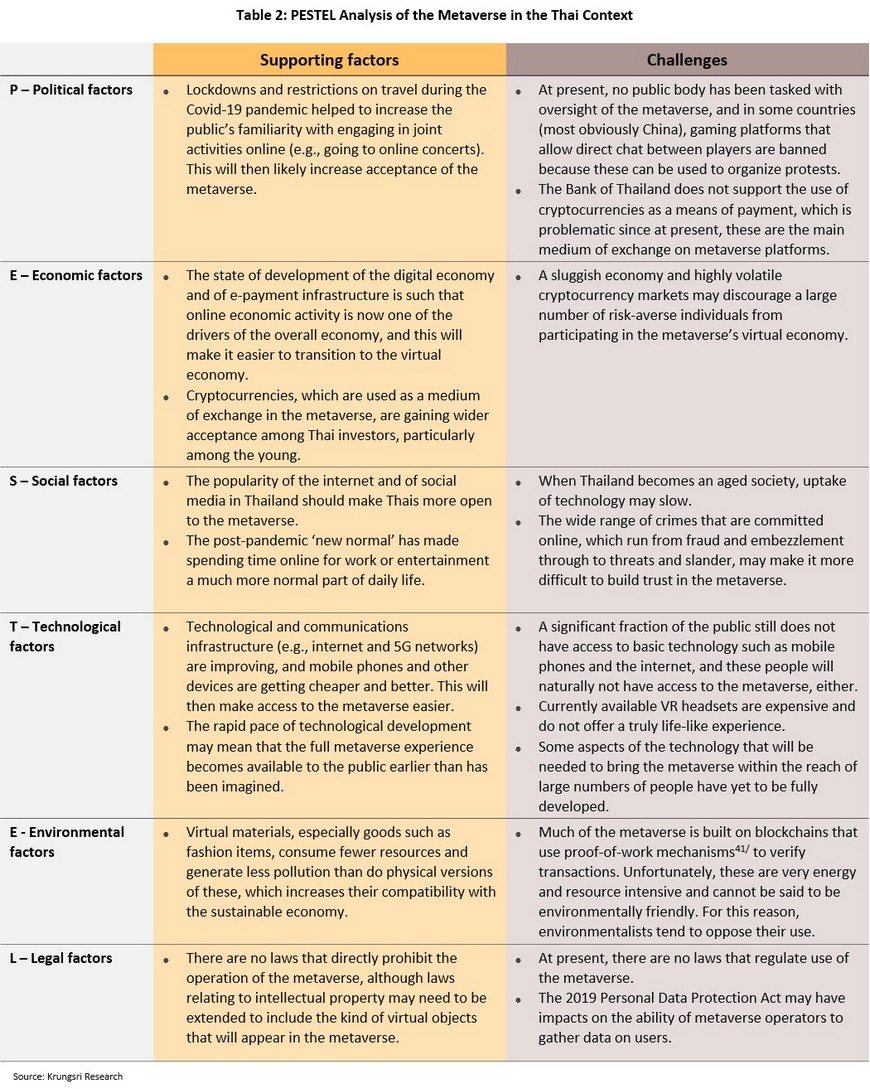
Krungsri Research view: Which way for banking in the metaverse?
It is clear that the advent of the metaverse will trigger another technological earthquake that will have significant impacts on day-to-day life. However, although early tremors may be felt in some areas in advance of the main event, the prospect of a Matrix-like integration of the metaverse into everyday life remains a distant prospect, and it will likely take at least 5-10 years for the metaverse to really begin to be felt. For much of the population then, time remains for a gradual acclimatization to this changing future.
As described above, JP Morgan (2022) has identified the stages through which a business should go when assessing the opportunities that might lie within the metaverse. This advice however might not be entirely applicable for banks since their major economic role is to act as financial intermediaries. However, economic thought related to the metaverse emphasizes the need for the virtual economy to be decentralized and disintermediated, and so the question then becomes, ‘Will banks have a role to play in the metaverse?’
If one compares the various functions and activities of the banking sector with the components of the metaverse, it can be seen that the greatest overlap occurs in areas related to the virtual economy and the direct application of the metaverse to banking operations, as described below.
- Products and services: Because digital assets are used as the primary means of making payments in the metaverse, if banks wish to fully participate in the metaverse and to offer goods and services within the virtual environment, they will need to develop their coverage of this area. This will need to include processing payments made with decentralized cryptocurrencies as well as centralized currencies such as stablecoins and CBDCs, understanding how to participate in the DeFi revolution, and designing new financial products (e.g., loans secured against NFTs).
- Customer experience (CX): In the more distant future, when use of the metaverse is integrated into normal day-to-day life, it is likely that accessing banking services in physical branches will fall even more out of favor than it is today, and bank customers will instead visit virtual branches more often. To prepare for this, it may therefore be necessary to train bank staff on how to meet customers and deliver services virtually. Beyond this, virtual branches may also have a greater role to play in organizing events in the metaverse and using these to enable customers to communicate with executives.
- Operations: Over the past two years of the pandemic, many banking staff with roles that were not tied directly to branch activities have been able to work from home, and this trend will benefit from the greater use of the metaverse, especially for meetings and other activities undertaken to coordinate work. Bill Gates, the founder of Microsoft, believes that within the next two years, online meetings will change from their current form, which relies on audio coupled to two-dimensional images, to a three-dimensional form that uses avatars42/. On the job training of bank staff will also benefit from being delivered via the metaverse, too.
- Risk: New types of financial products, most notably those connected with digital assets, will naturally carry with them new kinds of risk that cannot be easily assessed using existing models. If banks plan to move into the market for digital assets, they will thus need to develop new models for evaluating risk that are a closer fit with these new products. Careful thought will also need to be given to the overall exposure of the banking system to systemic risk arising from the sometimes wild turbulence in markets for digital assets.
In conclusion, whether one is talking about the metaverse, digital assets, or the blockchain, technological change remains rapid and relentless, but this should act as a stimulus to businesses and regulators to overhaul their operations. Likewise, this should spur on the development of human capital, which otherwise runs the risk of being left behind by the unstoppable rush of 21st century technology, ending up as nothing more than a relic from an earlier and now forgotten age, and reduced to being a curio in a virtual museum, somewhere in the metaverse in the future.
References
Aten, Jason (Oct 30, 2021) “5 Things Mark Zuckerberg Said About His Plan for the Metaverse That Should Make You Very Worried” Inc.com. Web. Retrieved Dec 21, 2021 from https://www.inc.com/jason-aten/5-things-mark-zuckerberg-said-about-his-plan-for-metaverse-that-should-make-you-very-worried.html
Baeriswyl, Jan, Jamie Burke, Rumi Morales, Robin Andre Nordnes, and Matus Steis (Dec 2021) “MetaFi: DeFi for the Metaverse” Outlier Ventures. Web. Retrieved Feb 24, 2022 from https://outlierventures.io/wp-content/uploads/2021/12/OV_MetaFi_Thesis_V1B.pdf
Ball, Matthew (Jan 13, 2020) The Metaverse: What It Is, Where to Find it, and Who Will Build It. Web. Retrieved Feb 14, 2022 from https://www.matthewball.vc/all/themetaverse
Chainlink (Nov 12, 021) What Is the Metaverse? Blog. Retrieved Jan 7, 2022 from https://blog.chain.link/what-is-the-metaverse/
Editorial Team (Nov 9, 2021) “Headed for the Metaverse: Banks’ Use of Virtual Reality Is on the Rise” The Financial Brand. Web. Retrieved Dec 1, 2021 from https://thefinancialbrand.com/124982/metaverse-banks-use-of-virtual-augmented-reality-facebook-training/
Gartner (Feb 7, 2022) Gartner Predicts 25% of People Will Spend At Least One Hour Per Day in the Metaverse by 2026. Press Release. Retrieved Feb 10, 2022 from https://www.gartner.com/en/newsroom/press-releases/2022-02-07-gartner-predicts-25-percent-of-people-will-spend-at-least-one-hour-per-day-in-the-metaverse-by-2026
Grayscale Research (November 2021) The Metaverse: Web 3.0 Virtual Cloud Economy. Web. Retrieved Dec 1, 2021 from https://grayscale.com/wp-content/uploads/2021/11/Grayscale_Metaverse_Report_Nov2021.pdf
Lee, Lik-Hang, Tristan Braud, Pengyuan Zhou, Lin Wang, Dianlei Xu, Zijun Lin, Abhishek Kumar, Carlos Bermejo, and Pan Hui (Sep 2021) “All One Needs to Know about Metaverse: A Complete Survey on Technological Singularity, Virtual Ecosystem, and Research Agenda” Virtual Ecosystem, and Research Agenda. 10.13140/RG.2.2.11200.05124/8.
Makarov, Andrew (Jan 21, 2022) “5 Key Technologies for the Development of the Metaverse” IoIforAll. Web. Retrieved Jan 26, 2022 from https://www.iotforall.com/5-key-technologies-for-the-development-of-the-metaverse
Molina, Brett (Dec 10, 2021) “Bill Gates predicts our work meetings will move to metaverse in 2-3 years” USA Today. Web. Retrieved Feb 22, 2022 from https://www.usatoday.com/story/tech/2021/12/10/bill-gates-metaverse-work-meetings-predictions/6459911001/
Newzoo (July 2021) Intro to the Metaverse: Newzoo Trend Report 2021. Web. Retrieved Jan 19, 2022 from https://newzoo.com/insights/trend-reports/newzoo-intro-to-the-metaverse-report-2021-free-version/
NuuNeoI (Feb 23, 2022) 7 Layers of the Metaverse องค์ประกอบ 7 เลเยอร์ที่ก่อมาเป็นเมตาเวิร์ส. Blog. Retrieved Feb 24, 2022 from https://nuuneoi.com/blog/blog.php?read_id=997
O’Brien, Matt, and Kelvin Chan (October 29, 2021) “EXPLAINER: What is the metaverse and how will it work?” The Associated Press. Web. Retrieved Dec 21, 2021 from https://apnews.com/article/meta-facebook-explaining-the-metaverse-f57e01cd5739840945e89fd668b0fa27
Preethi Kasireddy (July 7, 2021) What do Web 2.0 and Web 3.0 mean? Which one is better? Blog. Retrieved Dec 23, 2021 from https://www.preethikasireddy.com/post/what-do-web-2-0-and-web-3-0-mean-which-one-is-better
Radoff, Jon (Apr 7, 2021) “The Metaverse Value-Chain” Building the Metaverse. Web. Retrieved Feb 24, 2022 from https://medium.com/building-the-metaverse/the-metaverse-value-chain-afcf9e09e3a7
Ronald Leenes (2007) Privacy in the Metaverse :Regulating a complex social construct in a Virtual World. In IFIP International Summer School on the Future of Identity in the Information Society, Web. Retrieved Feb 8, 2022 from https://link.springer.com/content/pdf/10.1007/978-0-387-79026-8_7.pdf
Seeking Alpha (Sep 19, 2018) Web 3.0: From Global Database To Global Databank Web. Retrieved Dec 23, 2021 from https://seekingalpha.com/article/4207129-web-3_0-from-global-database-to-global-databank
Shaptunova, Yuliya (2021) “What Is Extended Reality and What Can We Do with It?” Sam Solutions. Blog. Retrieved Dec 24, 2021 from https://www.sam-solutions.com/blog/what-is-extended-reality-and-what-can-we-do-with-it/
Snider, Mike and Brett Molina (Nov 10, 2021) “Everyone wants to own the metaverse including Facebook and Microsoft. But what exactly is it?” USA Today. Web. Retrieved Feb 18, 2022 from https://www.usatoday.com/story/tech/2021/11/10/metaverse-what-is-it-explained-facebook-microsoft-meta-vr/6337635001/
Techsauce (Jan 18, 2022) Walmart ลุย Metaverse จริงจัง ยื่นขอเครื่องหมายการค้า ขายสินค้าเสมือนจริง เตรียมสร้าง NFTs และออก Crypto ของตัวเอง Web. Retrieved Jan 20, 2022 from https://techsauce.co/metaverse/walmart-filed-for-trademark-offering-virtual-goods-nfts-crypto
Techsauce (Jan 19, 2022) Microsoft เดินหน้า Metaverse ทุ่ม 6.8 หมื่นล้านเหรียญ เข้าซื้อ Activision Blizzard ถือเป็นดีลใหญ่ที่สุดในอุตสาหกรรมเกม Web. Retrieved Jan 20, 2022 from https://techsauce.co/metaverse/microsoft-acquired-activision-68-billion-dollars
Techtalk Thai (Jan 10, 2020) รู้จักกับ Digital Twin – เมื่อวัตถุต่างๆมีฝาแฝดอยู่ในโลกดิจิทัล Web. Retrieved Jan 10, 2022 from
Thaiware.com (Feb 6, 2021) “Web 3.0 คืออะไร ? และเทคโนโลยีที่จำเป็นต่อ Web 3.0” Tips & Trick. Web. Retrieved Dec 23, 2021 from https://tips.thaiware.com/1508.html
Theo (Aug 15, 2021) Metanomics — Building The Economy Of The Metaverse Blog. Retrieved Feb 24, 2022 from https://medium.com/@theo/metanomics-building-the-economy-of-the-metaverse-4b7b73f60c9f
Thomas, Lauren (Jan 16, 2022) “Walmart is quietly preparing to enter the metaverse” CNBC Web. Retrieved Jan 20, 2022 from https://www.cnbc.com/2022/01/16/walmart-is-quietly-preparing-to-enter-the-metaverse.html
VOA Thai (Nov 13, 2021) “เจาะลึกแบรนดิ้งใหม่ของเฟสบุ๊ค: “เมตาเวิร์ส” (Metaverse) คืออะไร?” เทคโนโลยี/นวัตกรรม Web. Retrieved Dec 21, 2021 from https://www.voathai.com/a/what-metaverse-how-will-it-work-explainer/6297369.html
โสภณ ศุภมั่งมี (Dec 13, 2021) “Metaverse: จาก The Matrix, Ready Player One สู่ Meta ของซักเคอร์เบิร์ก” The People Web. Retrieved Dec 15, 2021 from https://thepeople.co/metaverse/
-
pakgonhttps://pakgon.com/author/pakgon/
-
pakgonhttps://pakgon.com/author/pakgon/
-
pakgonhttps://pakgon.com/author/pakgon/
-
pakgonhttps://pakgon.com/author/pakgon/




